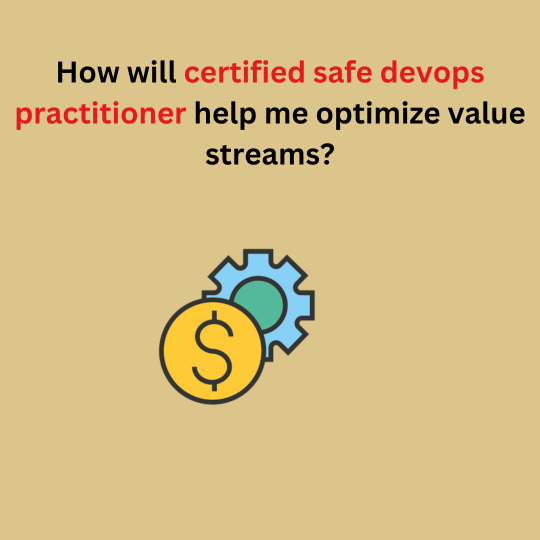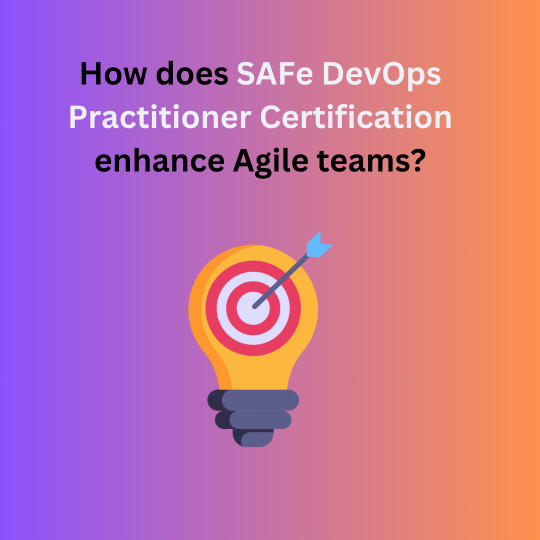#Safedevopscourse
Explore tagged Tumblr posts
Text
How will certified safe devops practitioner help me optimize value streams?
Introduction:-
The Certified SAFe DevOps Practitioner (SDP) course is a comprehensive training program designed to equip professionals with the skills and knowledge necessary to optimize value streams within their organizations. In an era where speed and efficiency are paramount, understanding how to enhance the flow of value through the Continuous Delivery Pipeline is crucial. Here’s how becoming a certified SAFe DevOps Practitioner can help you optimize value streams.
Understanding Value Streams
One of the foundational elements of the SAFe DevOps course is the concept of value streams. Participants learn how to map their current value streams from idea to cash, identifying every step involved in delivering a product or service. This mapping process is critical for visualizing how value flows through the organization and pinpointing areas where improvements can be made. By understanding the entire value stream, practitioners can identify bottlenecks and inefficiencies that hinder productivity.

Implementing Continuous Delivery Pipeline
The SAFe DevOps Practitioner certification emphasizes the importance of establishing a Continuous Delivery Pipeline (CDP). Participants learn how to design and implement a CDP that aligns with their organization’s needs. This pipeline supports continuous exploration, integration, deployment, and release on demand, allowing teams to deliver high-quality products more efficiently. By optimizing the CDP, organizations can reduce time-to-market and respond more effectively to customer demands.
Adopting the CALMR Approach
The CALMR (Culture, Automation, Lean, Measure, Recover) approach is a cornerstone of the SAFe DevOps framework. The training teaches practitioners how to cultivate a culture of shared responsibility for delivering value across teams. By fostering collaboration and communication, organizations can break down silos that often impede progress. Additionally, automation plays a vital role in enhancing efficiency; participants learn how to implement automated testing and deployment processes that streamline workflows and reduce manual errors.
Enhancing Collaboration Across Teams
SAFe DevOps training emphasizes the importance of collaboration among cross-functional teams. Certified practitioners are equipped with strategies to facilitate effective communication between development, operations, and other stakeholders involved in the delivery process. This collaborative mindset ensures that everyone is aligned toward common goals, ultimately improving the overall flow of value through the organization.
Continuous Improvement Through Metrics
Another significant aspect of optimizing value streams is measuring performance using relevant metrics. The SAFe DevOps course provides participants with tools such as the DevOps Health Radar and Transformation Canvas to evaluate their current state and identify areas for improvement. By regularly assessing key performance indicators (KPIs), organizations can make data-driven decisions that enhance their processes and increase efficiency.
Integrating Security Practices
In today’s digital landscape, integrating security into the delivery pipeline is essential for maintaining trust and compliance. The SAFe DevOps Practitioner training includes lessons on continuous security practices that ensure vulnerabilities are addressed throughout the development process. By embedding security measures into every stage of the pipeline, organizations can mitigate risks while optimizing their value streams.
Creating Actionable Transformation Plans
One of the key outcomes of the SAFe DevOps course is developing actionable plans for implementing DevOps transformations tailored to an organization’s unique needs. Participants learn how to create a roadmap for change that aligns with business objectives while addressing current challenges within their delivery processes. This strategic planning ensures that organizations can effectively optimize their value streams over time.
Conclusion
In summary, becoming a Certified SAFe DevOps Practitioner significantly enhances your ability to optimize value streams within your organization. Through understanding value stream mapping, implementing Continuous Delivery Pipelines, adopting the CALMR approach, enhancing collaboration, utilizing metrics for continuous improvement, integrating security practices, and creating actionable transformation plans, you will be well-equipped to drive meaningful change.
As organizations continue to seek ways to improve efficiency and responsiveness in delivering products and services, investing in SAFe DevOps Practitioner certification is a strategic step toward achieving these goals. Ultimately, this training empowers professionals to foster a culture of innovation and agility that delivers exceptional value in today’s competitive landscape.
0 notes
Text
How does SAFe DevOps Practitioner Certification enhance Agile teams?
Introduction :-
The SAFe DevOps Practitioner (SDP) certification is designed to empower professionals with the skills and knowledge necessary to implement DevOps practices within the Scaled Agile Framework (SAFe). As organizations increasingly adopt Agile methodologies to enhance their software delivery processes, the role of DevOps becomes critical. This blog explores how obtaining the SAFe DevOps Practitioner certification can significantly enhance Agile teams and improve their overall performance.
Fostering Collaboration Between Development and Operations
One of the primary benefits of the SAFe DevOps Practitioner certification is its focus on improving collaboration between development and operations teams. Traditionally, these two groups have operated in silos, often leading to miscommunication and delays in delivering value. The SDP certification emphasizes a shared DevOps mindset, encouraging team members to work together throughout the entire software development lifecycle. By breaking down these barriers, Agile teams can streamline their workflows, resulting in faster delivery times and higher-quality products.

Implementing Continuous Delivery Pipelines
The certification equips practitioners with the knowledge to develop and automate a Continuous Delivery Pipeline. This pipeline is essential for enabling Agile teams to deliver value incrementally and consistently. Participants learn how to map their current delivery processes, identify bottlenecks, and implement continuous integration, continuous testing, and continuous deployment practices. By mastering these skills, Agile teams can reduce lead times, minimize errors, and increase the frequency of deployments, ultimately enhancing their responsiveness to customer needs.
Encouraging a Culture of Continuous Improvement
A key aspect of the SAFe DevOps Practitioner certification is its emphasis on fostering a culture of continuous improvement within Agile teams. Certified practitioners are trained to facilitate regular retrospectives and feedback loops, allowing teams to reflect on their processes and identify areas for enhancement. This culture encourages experimentation and innovation, enabling teams to adapt quickly to changing requirements and continuously optimize their workflows. As a result, Agile teams become more resilient and better equipped to handle challenges.
Enhancing Quality Assurance Practices
Quality assurance is critical in any software development process. The SAFe DevOps Practitioner certification provides participants with tools and techniques to integrate quality into every stage of the development lifecycle. By implementing practices such as continuous testing and automated quality checks, Agile teams can identify defects early in the process, reducing the cost of fixing issues later on. This proactive approach to quality assurance not only improves product quality but also enhances customer satisfaction.
Improving Risk Management
The SAFe DevOps Practitioner certification emphasizes the importance of risk management within Agile environments. Participants learn how to identify potential risks early in the development process and implement strategies to mitigate them effectively. By fostering a culture of shared responsibility for risk management among team members, Agile teams can reduce the likelihood of release failures and improve their overall reliability. This proactive approach enables organizations to deliver solutions with greater confidence.
Aligning Work with Business Objectives
Certified SAFe DevOps Practitioners are trained to align their work with broader business objectives. This alignment ensures that Agile teams are not only focused on delivering features but also on delivering business value. By understanding how their work contributes to organizational goals, team members are more motivated and engaged in their tasks. This alignment fosters a sense of purpose within teams, leading to improved performance and better outcomes for the organization.
Conclusion
The SAFe DevOps Practitioner certification offers numerous benefits that significantly enhance Agile teams' capabilities and performance. From fostering collaboration between development and operations to implementing continuous delivery pipelines and promoting a culture of continuous improvement, this certification equips professionals with essential skills for success in today’s fast-paced software development landscape.
As organizations continue to embrace Agile methodologies, investing in SAFe DevOps Practitioner certification becomes increasingly valuable for individuals looking to advance their careers while contributing meaningfully to their teams' success. By enhancing collaboration, improving quality assurance practices, managing risks effectively, and aligning work with business objectives, certified practitioners play a crucial role in driving successful Agile transformations within their organizations.
#Safedevopscertification#Safedevopscourse#safedevopstraining#Safe devops#certified safe 5 devops practitioner
0 notes